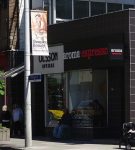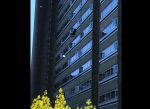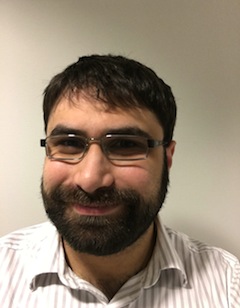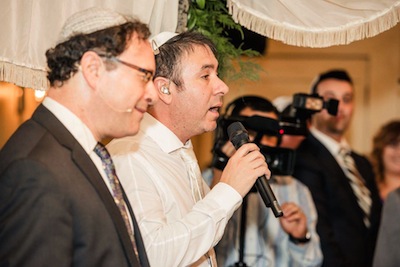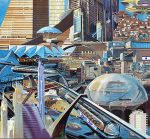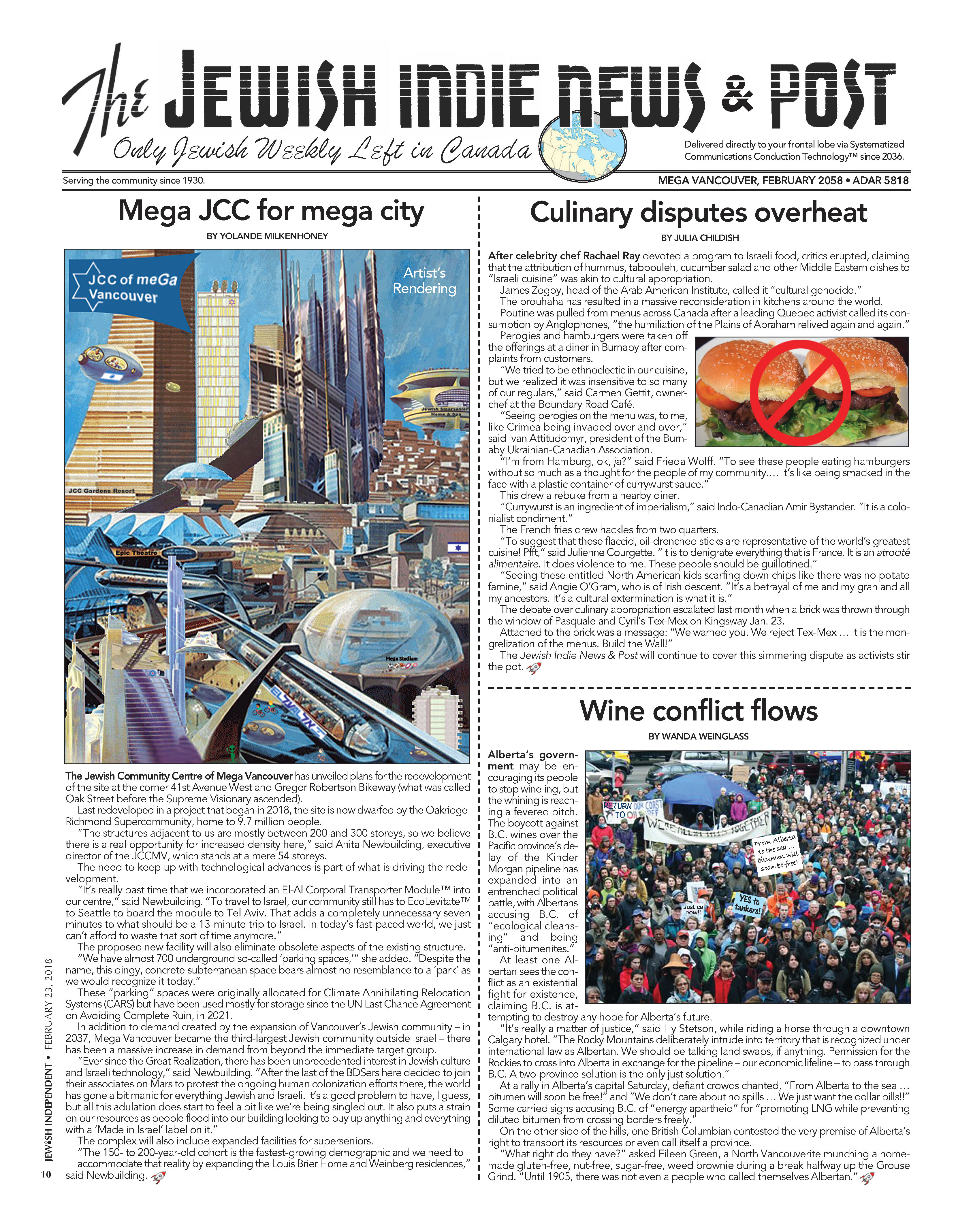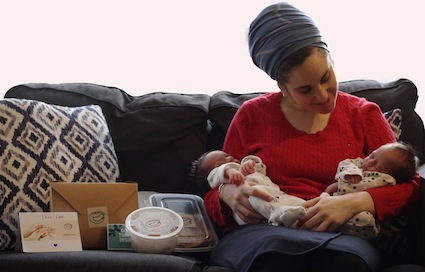Left to right are Jennifer Lines, Quelemia Sparrow and Marci T. House, who form part of the cast of Lysistrata. (photo by David Cooper)
At Bard on the Beach this summer, there is an eclectic mix of plays. There is Macbeth, set in its proper period, which runs in repertory on the BMO Stage with a Beatlemania version of As You Like It. On the more intimate Howard Family Stage, there is an experimental gender-role reversal take on little-known Timon of Athens and Lysistrata, a somewhat X-rated farcical romp through an ancient Greek tale, with a contemporary twist.
For Lysistrata, University of Victoria professor Jennifer Wise (Canadian Jewish Playwriting Competition winner) collaborated with director Lois Anderson to adapt Aristophanes’ 411 BCE comedic protest play about a group of Athenian and Spartan women who, tired of their husbands’ endless war-mongering, reluctantly decide to withhold sex until the men vow to give up fighting and stay at home with their families. You can probably guess what ultimately happens. But, to get there, the audience is led through a Monty Python meets Saturday Night Live series of misadventures replete with double entendres, an interesting use of plastic pool noodles and plenty of rollicking action.
The play’s backstory is Bard’s scheduled production of an all-female Hamlet that morphs into a dramatis interruptus as the company decides, at the last minute and with profuse apologies to the audience and artistic director Christopher Gaze, to stage Lysistrata this one night only to protest the pending rezoning of Vanier Park to make way for a shipping terminal. This leads to a lot of backing-and-forthing through ancient Greece and modern-day Vancouver interspersed with the ever-sublime Colleen Wheeler, as Hamlet, trying to get her “to be or not to be” soliloquy in, despite the change in plans, as she hauls “poor Yorick’s skull” around the set.
This is truly an ensemble cast and every member shines, but special mention must be made of Luisa Jojic’s role as the eponymous ring leader, Jennifer Lines as Mother Earth and Quelemia Sparrow’s poignant performance as an indigenous actor.
Mention must also be made of the two male artists (Sebastien Archibald and Joel D. Montgrand) who, as uniformed police officers, “stop” the performance to arrest one of the actors – who has defaced the rezoning signs and plastered graffiti all over the crab sculpture in front of the Planetarium – for public mischief. It all seems very real and is very funny, especially since one of the cops plays Wheeler’s husband, Ross.
In addition to Wise, other Jewish community members play prominent roles in the production. Mishelle Cutler makes her Bard debut as music director and one-woman orchestra. She uses 1930s Weimar cabaret-style music for the contemporary scenes, and opera and choral works for the more classic Greek theatre bits. Choreographer Tara Cheyenne Friedenberg takes that music and provides novel dance moves, especially for the quirky geriatric men versus women Athenian reel.
In keeping with the environmental theme of the night, the costumes and accessories are simple, to give credence to the improvised nature of the show. Head gear is made of hand bags, recycled water bottles and paper toilet rolls, a Starbucks cup does double duty as a wine chalice, costumes made from curtain rods and drapes (à la Carol Burnett’s iconic Gone With the Wind outfit) mix in with the actors’ own street clothes.
Ultimately, this mélange of Shakespeare, Greek theatre and contemporary activism should resonate with all of us, as we grapple with the reality of development in this city and its impact on our heritage and our way of life. While this show is a lot of fun, it may not be suitable for children under the age of 13.
* * *
Sometimes, you have to take risks with Shakespeare and director Meg Roe certainly does so with this adaptation of Timon of Athens. She admits in her notes that it is a “difficult play” and that it may not have been written solely by the Bard. It is the tale of a wealthy Athenian who wines and dines his friends and showers them with expensive gifts until he gets into financial difficulty. When he approaches those friends for help, they refuse. This sends him into a rage and, ultimately, to his death.
In the original version, the cast is predominantly male. In this adaptation, it is 2018, the set is a high-end condo in Vancouver and the cast is reminiscent of the Real Housewives women – uber wealthy, stiletto-heeled and shallow, constantly on their pinging/chirping phones.
Wheeler is sublime in her role as Timon and her manic meltdown into madness alone is worth the price of a ticket. She literally destroys the set. You have to give kudos to the stage crew, who have to rebuild the set for every performance, and to the costumers, who have to replace her white pantsuit every show. The set is stylish and sleek and the couture frocks divine. But, in the end, the basic takeaway is that money can’t buy you friends.
* * *
This summer’s Macbeth is the way Shakespeare intended it to be – in its proper Elizabethan period, with a stark set and eerie smoke and lighting effects. Perfect for a tale of greed, lust for power and revenge.
Early in the play, Macbeth (Ben Carlson) encounters three witches (the ones with the famous brew that includes the “liver of a blaspheming Jew”) who predict that he will be king of Scotland. Once Lady Macbeth (Moya O’Connell) hears of this, she sets out to convince her husband to murder King Duncan when the king visits their castle so that he, Macbeth, can reign. And so begins their downward spiral towards murder, death, destruction and madness.
Carlson and O’Connell are the crème de la crème of Canadian acting and exude an intense chemistry as the plotting Scots. Special mention must be made of Andrew Wheeler as a gruff Macduff and Craig Erickson as a ghostly Banquo.
* * *
Bard’s As You Like It is the must-see show of the summer. It is definitely a crowd-pleaser. And you will want to see it over and over again. Director Daryl Cloran has taken out half the Shakespearean text and inserted 25 of the Beatles’ top hits where appropriate in this tale of four pairs of young lovers (and the obstacles in their paths) so that, when one of the pairs, Rosalind (Lindsey Angell) and Orlando (Nadeem Phillip), locks eyes the for the first time, he breaks out in, “She loves you, ya, ya, ya.” Every situation easily morphs into a Beatles’ moment through songs like “Help,” “I Want to Hold Your Hand,” “Eight Days a Week” and so forth. The 1960s setting is split between urban Vancouver and the Okanagan, where various characters are exiled by the new duke on the block. There, in the wilderness, the four love stories unfold.
In addition, there is a pre-show display of Wildcat Wrestling, a psychedelic VW van parked on stage, a terrific four-piece band led by musical director Ben Elliott who does double duty as love-struck Silvius and is one half of a memorable and raunchy pas de deux with Jojic as Phoebe the shepherdess. That girl can belt out a song.
The standouts are the protagonists Angell and Phillip – they both sing and dance up a storm – Kayvon Khoshkam, who is simply terrific as the wrestling master of ceremonies and then later as the court fool, Touchstone, and Ben Carlson who, as the stereotypical beatnik, intellectual elitist, gives the audience a new take on the “all the world’s a stage” speech.
This is a fast-paced, fun night of music, song and dance that will have you humming these tunes all the way back home. Even old Will himself is probably rocking in his grave over Stratford-upon-Avon way.
* * *
Bard on the Beach runs to Sept. 22. For tickets to any of the shows and more information, go to bardonthebeach.org or call the box office at 604-739-0559.
Tova Kornfeld is a Vancouver freelance writer and lawyer.



